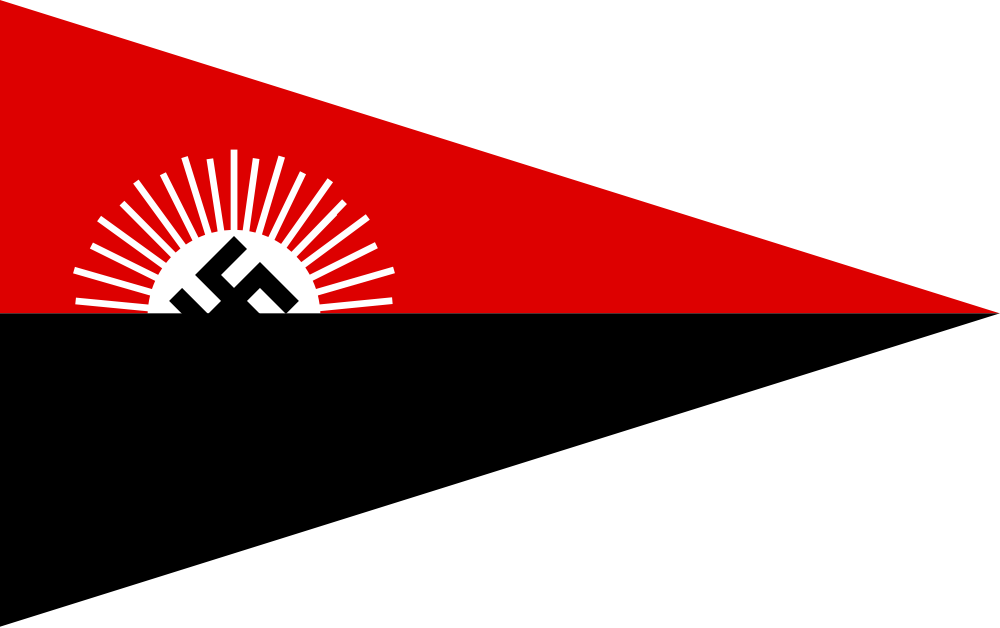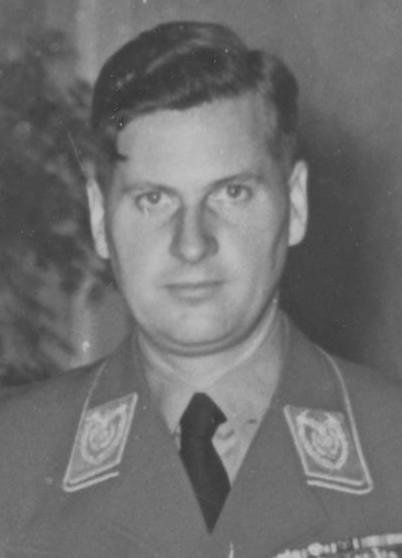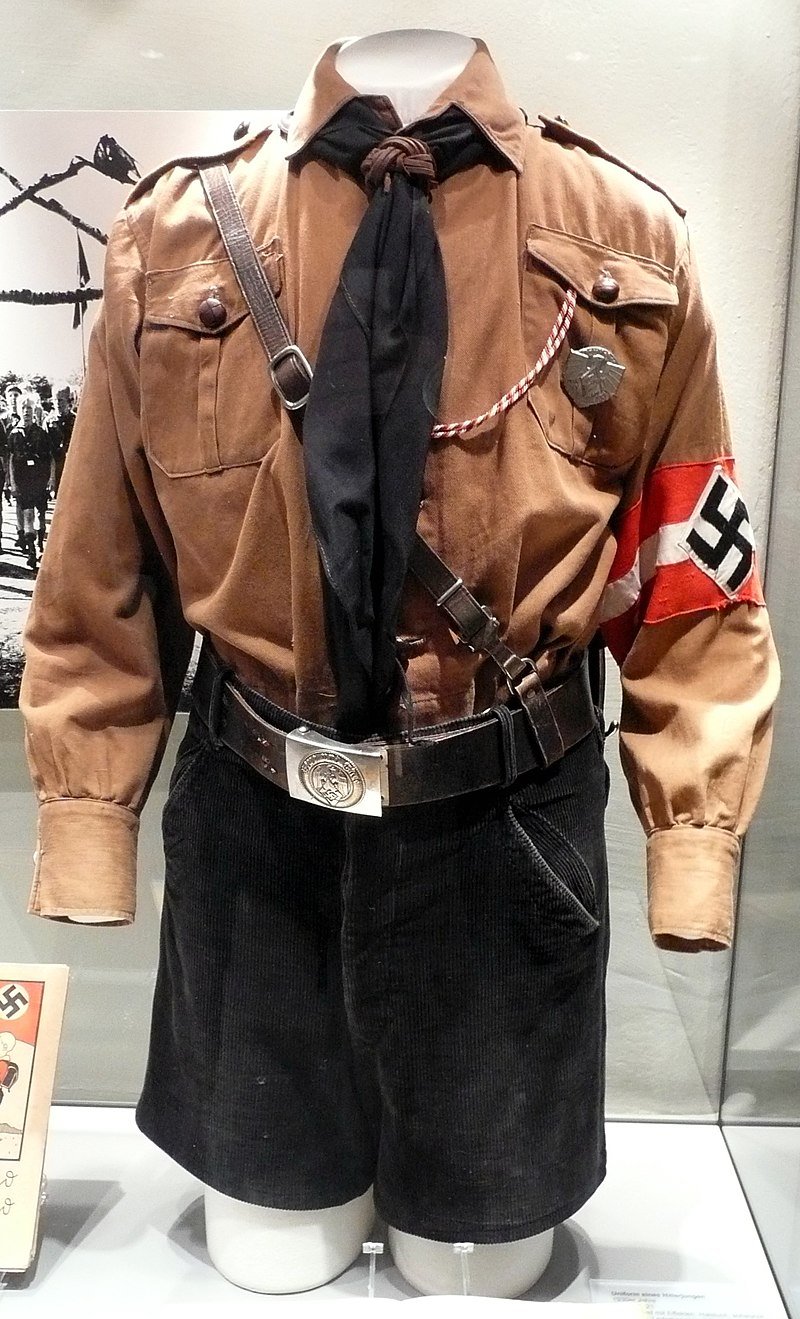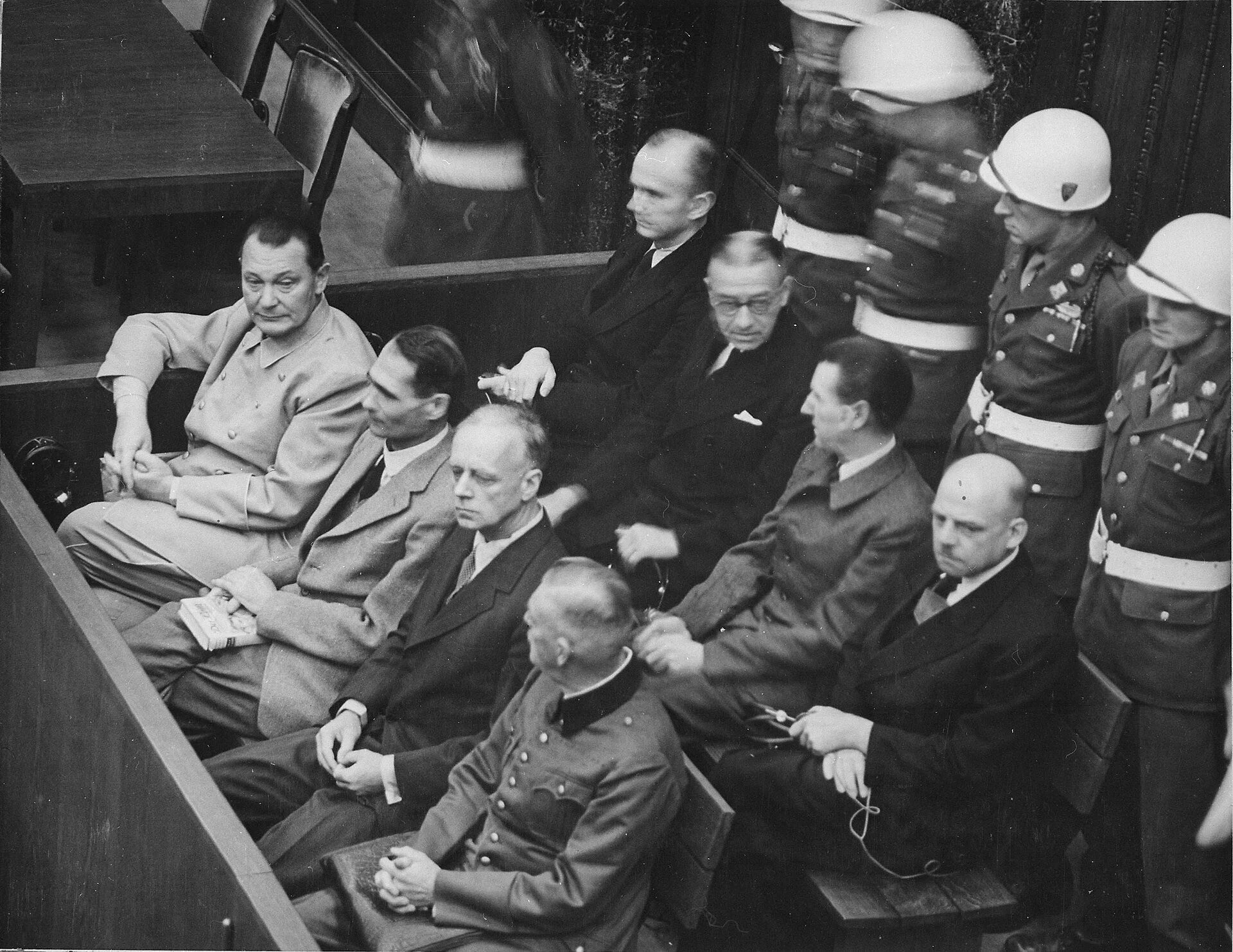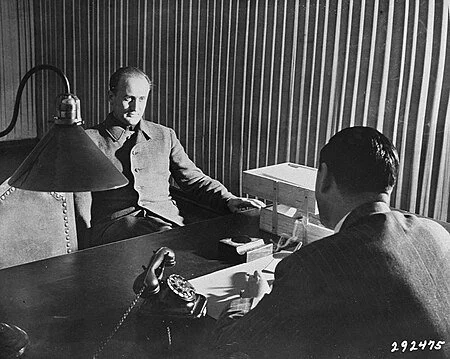
Hitler Youth
"The real, great educational act for a people lies in ingraining in youth blind obedience, unshakeable loyalty, unconditional comradeship and absolute reliability." (Schirach, 17 May 1938)
The Hitler Youth (German: Hitlerjugend), often abbreviated as HJ, was the youth organisation of the Nazi Party in Germany. Its origins date back to 1922 and it received the name Hitler-Jugend, Bund deutscher Arbeiterjugend ("Hitler Youth, League of German Worker Youth") in July 1926. From 1936 until 1945, it was the sole official boys' youth organisation in Germany and it was partially a paramilitary organisation. It was composed of the Hitler Youth proper for male youths aged 14 to 18, and the German Youngsters in the Hitler Youth (Deutsches Jungvolk in der Hitler Jugend or "DJ", also "DJV") for younger boys aged 10 to 14.
One reason the Hitler Youth so easily developed was that regimented organisations, often focused on politics, for young people and particularly adolescent boys were a familiar concept to German society in the Weimar Republic. Numerous youth movements existed across Germany prior to and especially after World War I. They were created for various purposes. Some were religious and others were ideological, but the more prominent ones were formed for political reasons, like the Young Conservatives and the Young Protestants. Once Hitler came onto the revolutionary scene, the transition from seemingly innocuous youth movements to political entities focused on Hitler was swift.
By 1930, the Hitlerjugend (HJ) had enlisted over 25,000 boys aged 14 and upward. They also set up a junior branch, the Deutsches Jungvolk (DJ), for boys aged 10 to 14. Girls from 10 to 18 were given their own parallel organisation, the League of German Girls (BDM).
In April 1932, Chancellor Heinrich Brüning banned the Hitler Youth movement in an attempt to stop widespread political violence. However, in June, Brüning's successor as Chancellor, Franz von Papen, lifted the ban as a way of appeasing Hitler, the rapidly ascending political star. A further significant expansion drive started in 1933, after Baldur von Schirach was appointed by Hitler as the first Reichsjugendführer (Reich Youth Leader). All youth organizations were brought under Schirach's control.
HJ propaganda poster
Doctrine
The members of the Hitler Youth were viewed as ensuring the future of Nazi Germany and they were indoctrinated in Nazi ideology, including racism. The boys were indoctrinated with the myths of Aryan racial superiority and to view Jews and Slavs as subhumans. Members were taught to associate state-identified enemies such as Jews with Germany's previous defeat in the First World War and societal decline. The Hitler Youth were used to break up church youth groups, spy on religious classes and Bible studies, and interfere with church attendance. Education and training programs for the Hitler Youth were designed to undermine the values of traditional structures of German society. Their training also aimed to remove social and intellectual distinctions between classes, to be replaced and dominated by the political goals of Hitler's totalitarian dictatorship. Sacrifice for the Nazi cause was instilled into their training. As historian Richard Evans observes, "The songs they sang were Nazi songs. The books they read were Nazi books." Former Hitler Youth Franz Jagemann said that the notion "Germany must live" even if the members of the HJ had to die, was "hammered" into them.
The Hitler Youth appropriated many of the activities of the Boy Scout movement (which was banned in 1935), including camping and hiking. However, over time it changed in content and intention. For example, many activities closely resembled military training, with weapons familiarization, assault course circuits, and basic fighting tactics. The aim was to turn the HJ into motivated soldiers. There was greater emphasis on physical ability and military training than on academic study. More than just a way to keep the German nation healthy, sports became a means of indoctrinating and training its youth for combat; this was in keeping with tenets outlined in Hitler's notorious work, Mein Kampf. In a 1936 edition of Foreign Affairs, an article discussing the appropriation of sports by contemporary dictatorial regimes such as Nazi Germany, commented that:
The dictators have discovered sport. This was inevitable. Middle-aged and older persons have their roots in the ground, have affiliations with former régimes. The hope of the dictators, therefore, was to win over youth to the new conception of life, the new system. They found that they could best succeed through sport. From being a simple source of amusement and recreation, it became a means to an end, a weapon in the hands of the All Highest. It became nationalistic. The ideal of sport for sport's sake became an object of ridicule. The real preoccupation of those who directed athletics became the mass production of cannon fodder.
Organisation
The Hitler Youth was organised into corps under adult leaders, and the general membership of the HJ consisted of boys aged 14 to 18. The Hitler Youth was organised into local cells on a community level. Such cells had weekly meetings at which various Nazi doctrines were taught by adult leaders. Regional leaders typically organised rallies and field exercises in which several dozen Hitler Youth cells would participate. The largest gathering usually took place annually at Nuremberg, where members from all over Germany would converge for the annual Nazi Party rally. Since the HJ and BDM were considered fully Aryan organizations by Nazi officials, premarital sex was encouraged in their ranks. This did not conform to the general beliefs of the Nazi Party, which viewed premarital sex as undesirable and a potential public health hazard.
The Hitler Youth maintained training academies comparable to preparatory schools, which were designed to nurture future Nazi Party leaders. The Hitler Youth also maintained several corps designed to develop future officers for the Wehrmacht (Armed Forces). The corps offered specialised foundational training for each of the specific arms for which the member was ultimately destined. The Marine Hitler Youth (Marine-HJ), for example, served as an auxiliary to the Kriegsmarine. Another branch of the Hitler Youth was the Deutsche Arbeiter Jugend – HJ (German Worker Youth – HY). This organisation within the Hitler Youth was a training ground for future labour leaders and technicians. Its symbol was a rising sun with a swastika. A program entitled Landjahr Lager (Country Service Camp) was designed to teach specifically chosen girls of the BDM high moral character standards within a rural educational setting.
Hitler Youth at rifle practice,1943
Flag of the Deutsche Arbeiter Jugend
Emblem of the Hitler youth
Membership
By December 1936, Hitler Youth membership had reached over five million. That same month, membership became mandatory for Aryans under the Gesetz über die Hitlerjugend (Hitler Youth Law). This legal obligation was reaffirmed in March 1939 with the Jugenddienstpflicht (Youth Service Duty), which conscripted all German youths into the Hitler Youth—even if the parents objected. Parents who refused to allow their children to join were subject to investigation by the authorities. From then on, the vast majority of Germany's teenagers belonged to the Hitler Youth. By 1940, it had eight million members.
A number of employers refused to offer apprenticeships to anyone who was not a member of the Hitler Youth. By 1936, the Hitler Youth had a monopoly on all youth sports facilities in Germany, effectively locking out non-members. Hitler spoke of the regime's ability to make Nazis out of these German youth, exclaiming in 1938:
These boys and girls enter our organizations with their ten years of age, and often for the first time get a little fresh air; after four years of the Young Folk they go on to the Hitler Youth, where we have them for another four years...And even if they are still not complete National Socialists, they go to Labor Service and are smoothed out there for another six, seven months...And whatever class consciousness or social status might still be left...the Wehrmacht will take care of that.
The HJ and BDM differences
Hitler Youth members give the Nazi salute at a rally at the Lustgarten in Berlin, 1933
Baldur von Schirach was appointed by Hitler as the first Reichsjugendführer (Reich Youth Leader).
In 1933, Hitler Youth (HJ) took over all youth movements in Germany, except Catholic ones (which were eliminated in 1936).
The HJ aimed to:
control the activities of young people outside the classroom;
make them loyal to Hitler;
train boys to be soldiers and prepare girls to be wives and mothers.
There were separate organisations for boys and girls, and for different age groups.
Boys enrolled in the movement at six years old, and joined the main group, Hitler Youth (HJ), at 14. By 1939, 90 per cent of German boys aged 14 and over were members.
Girls enrolled in the movement at the age of 10. They moved into the main wing, the League of German Maidens (BDM), at the age of 14.
There were different activities for boys and girls. Boys fired guns and marched, while girls learnt how to look after a family, but all undertook fitness and indoctrination classes.
There were many reasons why young people joined the movements:
Initially membership was voluntary, but it was made compulsory in 1936.
Young people also joined because of peer pressure.
They were attracted by the novel activities, such as camping.
It was a chance to reject the authority and values of their parents.
Membership would help them get university places and a better job in the future.
Many joined hoping that by showing loyalty to the Nazis, their families would be safe from the SS.
Hitler Youth Uniform
World War II
By 1938, 30,000 Hitler Youth leaders had received weapons training. On 15 August 1939, a fortnight before the beginning of World War II, Schirach agreed with General Wilhelm Keitel that the entire Hitler Youth leadership must have "defence training".
On 1 May 1940, Artur Axmann was appointed deputy to Schirach, whom he succeeded as Reichsjugendführer of the Hitler Youth on 8 August 1940. Axmann began to reform the group into an auxiliary force which could perform war duties. The Hitler Youth became active in German fire brigades and assisted with recovery efforts to German cities affected by Allied bombing. The Hitler Youth also assisted in such organisations as the Reich postal service, the Reich railway services, and other government offices; members of the HJ also aided the army and served with anti-aircraft defence crews.
In 1942 Hitler decreed the establishment of "Hitler Youth defence training camps", led by Wehrmacht officers. Nazi leaders began turning the Hitler Youth into a military reserve to replace manpower which had been depleted due to tremendous military losses. The idea for a Waffen-SS division made up of Hitler Youth members was first proposed by Axmann to Reichsführer-SS Heinrich Himmler in early 1943. The plan for a combat division made up of Hitler Youth members born in 1926 was passed on to Hitler for his approval. Hitler approved the plan in February and Gottlob Berger was tasked with recruiting.
Artur Axmann German Nazi national leader (Reichsjugendführer) of the Hitler Youth
Members of the Hitler Youth chosen by the NSDAP Office of Racial Policy
Fritz Witt of SS Division Leibstandarte (LSSAH) was appointed divisional commander.
In 1944, the 12th SS-Panzer-Division Hitlerjugend was deployed during the Battle of Normandy against the British and Canadian forces to the north of Caen. Over 20,000 German youths participated in the attempt to repulse the D-Day invasion; while they knocked out 28 Canadian tanks during their first effort, they ultimately lost 3,000 lives before the Normandy assault was complete.[60] During the following months, the division earned a reputation for ferocity and fanaticism. When Witt was killed by Allied naval gunfire, SS-Brigadeführer Kurt Meyer assumed command and became the divisional commander at age 33.
As German casualties escalated with the combination of Operation Bagration and the Lvov-Sandomierz Operation in the east, and Operation Cobra in the west, members of the Hitlerjugend were recruited at ever younger ages. By 1945, the Volkssturm was commonly drafting 12-year-old Hitler Youth members into its ranks. During the Battle of Berlin, Axmann's Hitler Youth formed a major part of the last line of German defence, and they were reportedly among the fiercest fighters. Although the city commander, General Helmuth Weidling, ordered Axmann to disband the Hitler Youth combat formations, in the confusion this order was never carried out. The remnants of the youth brigade took heavy casualties from the advancing Russian forces. Only two survived.
In 1945, there were various incidents of Hitler Youth members shooting prisoners and participating in executions
Fritz Witt of SS Division Leibstandarte (LSSAH) was appointed divisional commander.
SS-Brigadeführer Kurt Meyer assumed command and became the divisional commander at age 33.
Gottlob Christian Berger in charge of recruting Hitler youth into the SS cpmbat division
16-year-old Willi Hübner being awarded the Iron Cross in March 1945
Post-World War II
The Hitler Youth was disbanded by Allied authorities as part of the denazification process. Some Hitler Youth members were suspected of war crimes but, because they were children, no serious efforts were made to prosecute these claims. While the Hitler Youth was never declared a criminal organisation, its adult leadership was considered tainted for corrupting the minds of young Germans. Many adult leaders of the Hitler Youth were put on trial by Allied authorities, and Baldur von Schirach was sentenced to 20 years in prison. However, he was convicted of crimes against humanity for his actions as Gauleiter of Vienna, not for his leadership of the Hitler Youth, because Artur Axmann had been serving as the functioning leader of the Hitler Youth from 1940 onward. Axmann only received a 39-month prison sentence in May 1949, but he was not found guilty of war crimes.
German children born in the 1920s and 1930s became adults during the Cold War years. Since membership was compulsory after 1936, it was neither surprising nor uncommon that many senior leaders of both West and East Germany had been members of the Hitler Youth. Little effort was made to blacklist political figures who had been members, since many had little choice in the matter. These German post-war leaders were nonetheless once part of an important institutional element of Nazi Germany. Historian Gerhard Rempel opined that Nazi Germany itself was impossible to conceive without the Hitler Youth, as their members constituted the "social, political, and military resiliency of the Third Reich" and were part of "the incubator that maintained the political system by replenishing the ranks of the dominant party and preventing the growth of mass opposition."
Baldur von Schirach (in second row, second from right) at the Nuremberg Trials seated with other high-ranking Nazis
Interrogation of Axmann in Nuremberg, 16 October 1947
World War II: The Hitler Youth | Full Movie (Feature Documentary)




